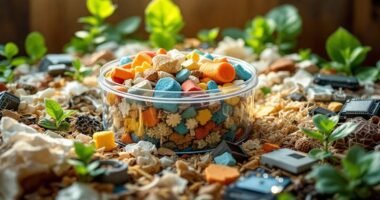Exploring sustainable packaging alternatives is like choosing between a salad and a cheeseburger—both have their merits, but one is definitely kinder to the planet. Options like compostable packaging made from corn or bamboo break down in just 180 days, while bioplastics boast a smaller carbon footprint. Then there are innovative materials like mushroom and seaweed wraps that completely sidestep plastic. A little eco-conscious effort can reduce emissions and tap into the growing consumer demand for greener choices. Curious about more?

In a world where the average person tosses out about 4.4 pounds of waste each day, the quest for sustainable packaging alternatives has never been more urgent—or exciting. Imagine the Earth as a giant recycling bin, overflowing with a mishmash of plastic and paper that seems to mock our environmental efforts. Enter the heroes of the packaging world: compostable materials, recycled goods, and bioplastics, all vying for a chance to save the day (and the planet).
Compostable packaging, crafted from plant-based materials like corn and bamboo, promises to break down in home compost within 180 days—almost faster than your leftovers mysteriously disappear. With biodegradable options like PLA (polylactic acid) and PBAT polymers, these materials are not just eco-friendly; they also help reduce our reliance on fossil fuels. It’s like trading in Grandma’s gas-guzzler for a snazzy electric car—goodbye, emissions! Consumer demand is driving the shift towards sustainable packaging, with 82% of consumers willing to pay more for eco-friendly options. Additionally, compostable materials, such as plant-based packaging, help support environmentally responsible practices by breaking down quickly in composting systems.
Recycled materials, on the other hand, are the dependable sidekicks in this sustainability saga. By reusing paper, cardboard, and even plastics, we cut down on waste and the need for virgin resources. Sure, there are challenges like contamination (think of the villainous coffee cup that ruins the whole batch), but recycled plastics use a whopping 95% less energy than their virgin counterparts. It’s like finding out that your favorite pizza joint serves calorie-free slices; happiness is just a call away!
Then, there are bioplastics, derived from renewable sources like corn starch. They strut their stuff with a smaller carbon footprint compared to traditional plastics, making them the eco-champions of the packaging arena. As markets expand, these materials are set to make a serious impact.
Lastly, innovative materials like mushroom-based packaging and seaweed wraps are the quirky rebels of the group. They require no pesticides and are often 100% compostable. Imagine your packaging dissolving in water like a sugar cube in tea—now that’s some magic worth celebrating!
Navigating this landscape of sustainable options is akin to a thrilling treasure hunt, where the ultimate prize is a cleaner, greener planet.
Frequently Asked Questions
How Can I Determine the Environmental Impact of Different Packaging Materials?
To determine the environmental impact of different packaging materials, one must consider factors like carbon footprint, water usage, and recyclability. A Life Cycle Assessment (LCA) is like a detective, investigating each stage from raw material extraction to disposal.
What Certifications Should I Look for in Sustainable Packaging?
When searching for sustainable packaging, look for specific certifications that act like a trusty roadmap. The Global Recycled Standard (GRS) indicates recycled content, while BPI certification verifies compostability—like a green stamp of approval.
Forest Stewardship Council (FSC) guarantees responsible sourcing, much like checking if your coffee is fair trade. These certifications help consumers make choices that support the planet, turning eco-friendly dreams into tangible actions, one package at a time.
Are There Cost-Effective Sustainable Packaging Options for Small Businesses?
Cost-effective sustainable packaging options abound for small businesses keen to green their operations without breaking the bank. Think corrugated cardboard boxes and recycled kraft paper—both recyclable and budget-friendly.
Recycled plastic mailers offer a wallet-friendly alternative, while compostable mailers are perfect for eco-conscious shipments. With a little creativity, using bulk purchasing and smart design can also cut costs.
Who knew saving the planet could be so economically savvy?
How Can I Educate Consumers About My Sustainable Packaging Choices?
To educate consumers about sustainable packaging choices, businesses can employ a mix of clear communication and engaging content. Simple recycling instructions and eye-catching symbols are essential, while QR codes can lead curious minds to deeper insights. Training staff to discuss these features adds a personal touch.
Hosting workshops or social media campaigns makes learning fun, turning consumers into eco-warriors. It’s like hosting a dinner party where everyone leaves not just full, but inspired to change the world
What Are the Challenges of Transitioning to Sustainable Packaging?
Shifting to sustainable packaging presents several challenges. For starters, production costs can skyrocket, making wallets groan louder than a toddler denied dessert.
Material performance is another hurdle; not every eco-friendly option protects products like a trusty old bubble wrap. Infrastructure issues, like sparse recycling facilities, add to the chaos.
Finally, maneuvering regulations can feel like a maze, with businesses needing to meet diverse standards while trying to stay innovative. It’s a balancing act, for sure.









